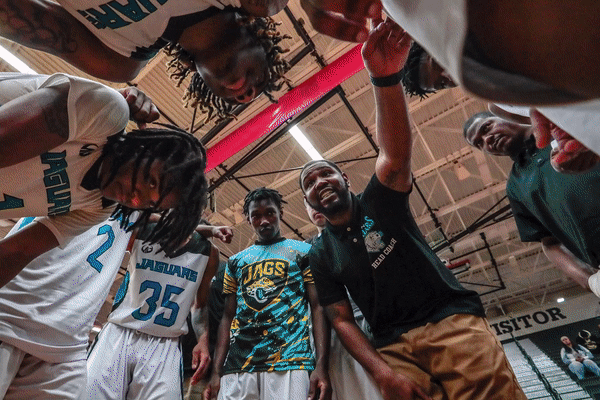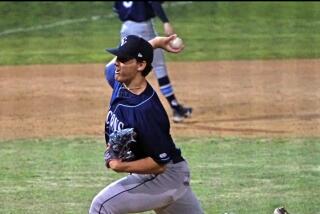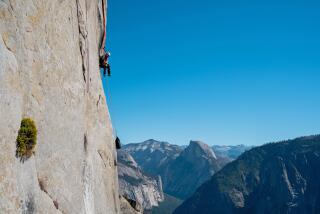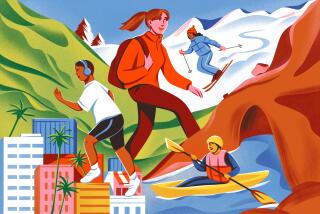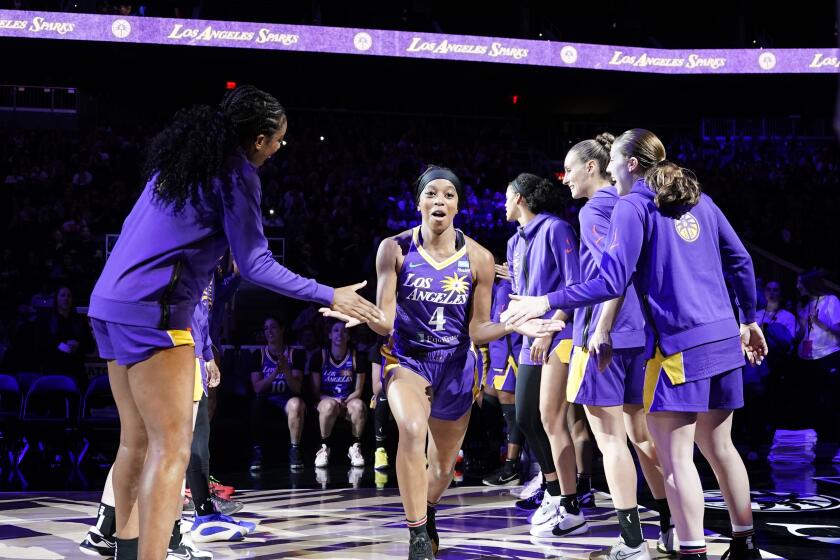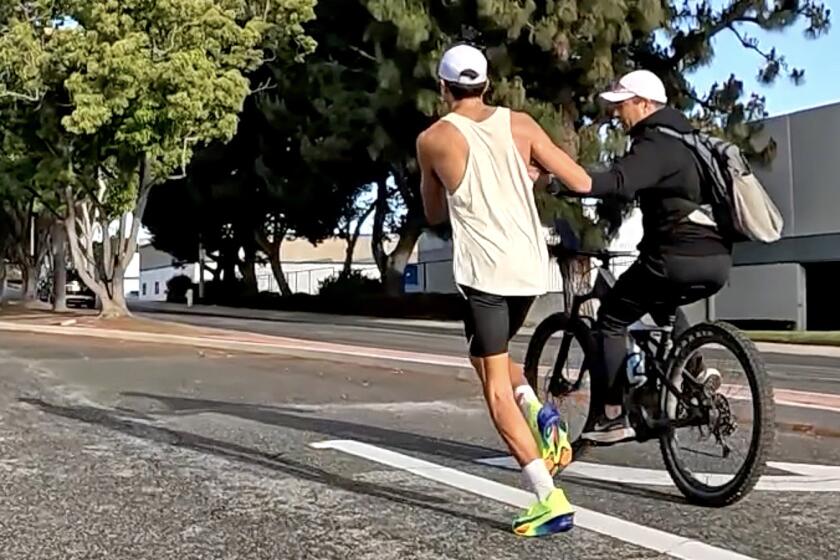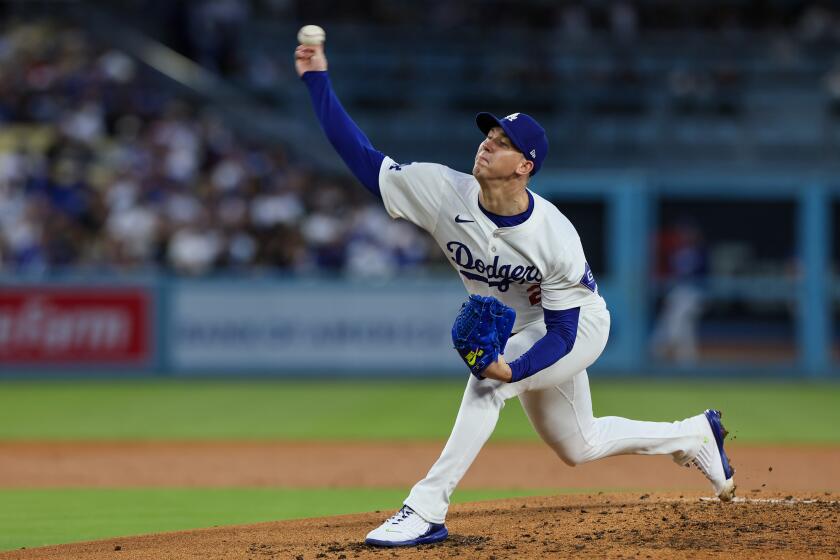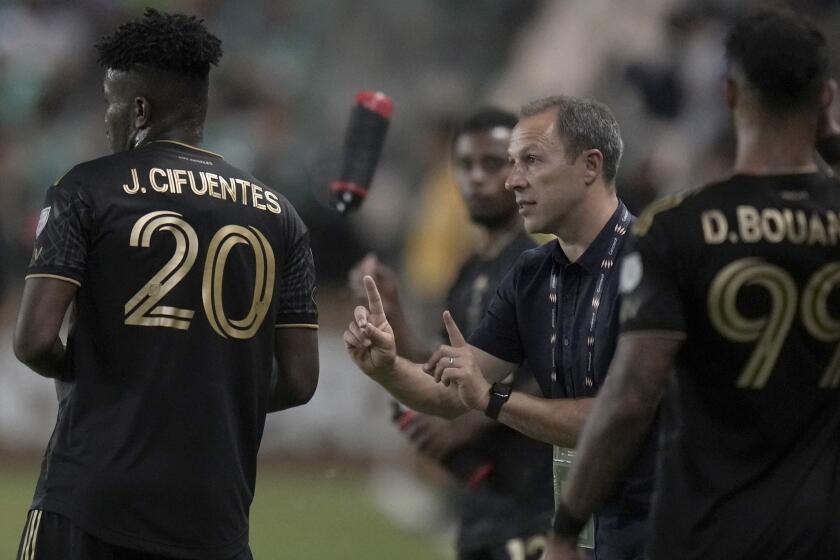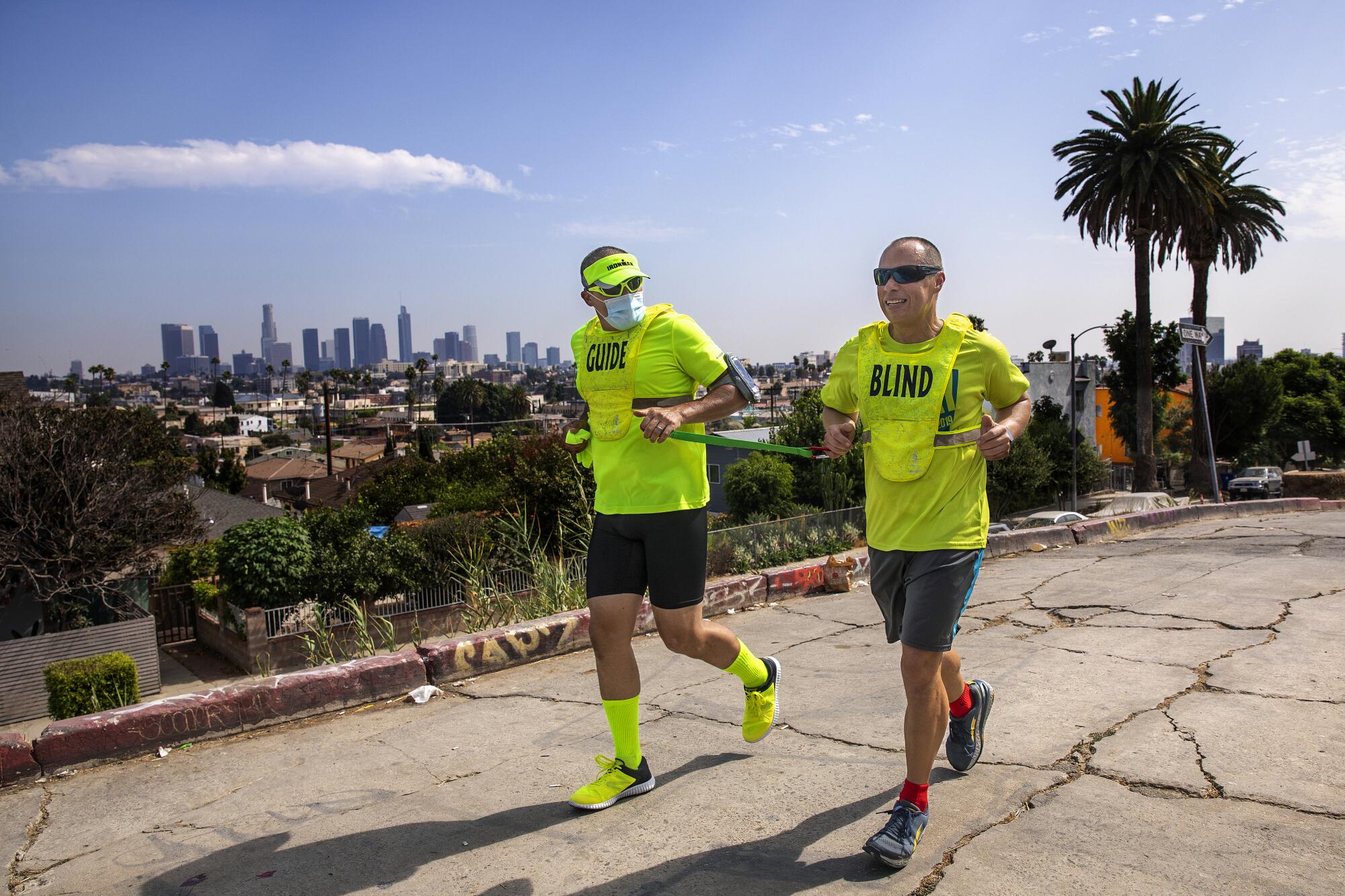
The two men’s vests lit up in the afternoon sunlight, their neon-yellow running tops identical in every way except one.
In bolded block letters, “GUIDE” was written across the chest of one. The other displayed a different word: “BLIND.”
The latter belongs to Tony Duenas, a 53-year-old Angeleno with a stout, muscular build, thick runner’s calves and soft hazel eyes that no longer give him sight — the result of a sudden retinal detachment in 2009 that left him permanently blind.
“It was scary,” he said. “I didn’t know what I could do. I was blind. I had no idea.”
Every day since has been a battle for independence, a test in self-sufficiency. At first, he feared the idea of living in perpetual darkness. But then he found a way to rediscover the light.
With the help of a network of sighted guides — who have also become some of his closest friends — Duenas became a long-distance runner and triathlete six years ago. He has completed seven marathons, three triathlons, three half-Ironman triathlons and dozens of other races commemorated by a hoard of medals hanging from his living-room wall.
“Not having sight has given me these amazing opportunities that I would have never had.”
— Tony Duenas
He goes on miles-long swims around Naples Island in Long Beach and tandem bike rides throughout the Southland that can last for hours.
When he still had sight, he was overweight, out of shape and battled a blood-pressure problem. Now, exercise and endurance athletics have renewed his strength and ambition, sources of empowerment and freedom that bind together his new way of life.
“Never in my wildest dreams would I have ever thought that I would be doing an Ironman or marathons,” he said. “Not having sight has given me these amazing opportunities that I would have never had.”
Then last spring, the COVID-19 pandemic came and threatened to take it all away.
::
Duenas’ old life was nothing like this.
He was born in Mexico, and his family moved to Los Angeles when he was a toddler. He graduated from Cathedral High School and worked his way through college, flipping burgers at McDonald’s while earning a degree from Cal State L.A.
Eventually, he landed a logistics job with American Express and moved into a cozy one-bedroom apartment on a hillside in Filipinotown, where sweeping views of the city’s skyline beckoned just around the corner. He loved to read and often got up early on weekends to watch tennis on TV.
Then one morning in 2009, he woke up and couldn’t see out of one eye.
“I’m rubbing my eyes,” Duenas said, “thinking, ‘What the heck?’ ”

That afternoon, doctors discovered that one of his retinas — the thin, light-sensitive nerve tissue layer of the eye where images are focused, converted to electrical impulses and sent to the brain for sight — had detached and the other was about to go. Within days, they told him, he would be totally blind.
“Think about the eye like a camera,” said Dr. Vivienne Hau, a retinal surgeon at the Kaiser Permanente Riverside Medical Center and clinical assistant professor at the Kaiser Permanente Bernard J. Tyson School of Medicine. “You have a lens in the front, and it focuses a sharp image onto the film in the back of your eye. That film in the back of your eye is the retina. As you can imagine, if that film has any damage to it, the photograph will come out distorted or blacked out.”
Many conditions can lead to a retina detachment, where the retina separates from the wall of the eye. Fluid can accumulate under the retina, sometimes leaking out from blood vessels or collecting as a result of a hole or tear formed either from trauma or spontaneously. Scar tissue formed from conditions such as diabetes can also cause a detachment.
There are common symptoms, such as a “floaters” and “flashers” appearing in one’s vision or a “black curtain” partially obscuring eyesight, but Duenas never noticed any of the warning signs. (He later remembered having some floating lines in his vision but didn’t recognize them as a problem at the time.)
He underwent an attempted reattachment surgery but only salvaged faint light sensitivity on his right side. He can vaguely make out shadows, but even that has deteriorated over the years.
“I would kill to have the sun batter me again,” he said.
Hau, who didn’t treat Duenas but later met him through her own involvement with the blind running community, has found that “for most folks, their biggest health fear outside of cancer is going blind.”
At only 32, Courtney Stockmal has accomplished a lot in a relatively short time in her rise to become a leading name in sports broadcast production.
And in Duenas’ case, he was 42 years old and living on his own when he suddenly had to adapt to life without sight.
“I always had my family,” he said, “but the last thing I wanted to do was be a burden on my mom or my dad or my sisters.”
::
There’s almost nothing about life that doesn’t change for a person who suddenly becomes blind.
Duenas can attest. Following his retinal detachment, he spent six months at a school for visually impaired adults, running his fingers over braille books for hours until he recognized each letter by heart.
When he returned home, he learned the city bus system and walked the streets around his apartment every day, memorizing the layout of each block to the step. He gave up his car, got rid of his TV and boxed up his books. He rearranged his belongings, moving essentials to easy-to-access places.
For the first time, he began seriously exercising too, enrolling in boxing classes, a CrossFit gym and jiu-jitsu lessons (a “blind-friendly sport,” he said, because “it’s all touch”).
Then came the day that changed Duenas’ life forever.
It was November 2014, and Duenas was walking to a bus stop when a random jogger on the street stopped him out of the blue and asked a simple question.
“Can you run?”
“Having guides is the ticket to our freedom. To be able to do marathons, half-marathons, everything. They’re gold.”
— Tony Duenas
The man’s name was Ray Alcanter, a longtime marathon runner and triathlete who had previously guided a visually impaired older woman before she retired from the activity. He wasn’t actively seeking a new blind running partner the day he crossed paths with Deunas. But when he noticed Duenas’ white cane and athletic physique, he felt compelled to stop and ask.
“He looked physically fit. He looked like he worked out, so I thought to myself, ‘I wonder if he’d be interested in training for a marathon?’ ” Alcanter said. “It was just a spur of the moment-type thing.”
Before then, distance running hadn’t crossed Duenas’ mind. The gyms and classes he took came with extreme structure and personalized attention, with trainers who could deliberately guide his every movement in a controlled setting. Running, even with the help of a sighted guide, seemed risky, if not impossible.
But then Alcanter explained to Duenas how the process worked. The two would run side-by-side, each holding the end of a foot-long nylon tether. Alcanter would act as Duenas’ eyes, alerting him to obstacles and keeping him on course. But Duenas would be running for himself with minimal help and maximum freedom.
“It’s all about trust,” Alcanter said.
Duenas was still unsure but intrigued enough to give Alcanter his phone number. Before Alcanter left, he asked Duenas one last question.
“Tony, can I take your picture? I know this is going to be an important day.”
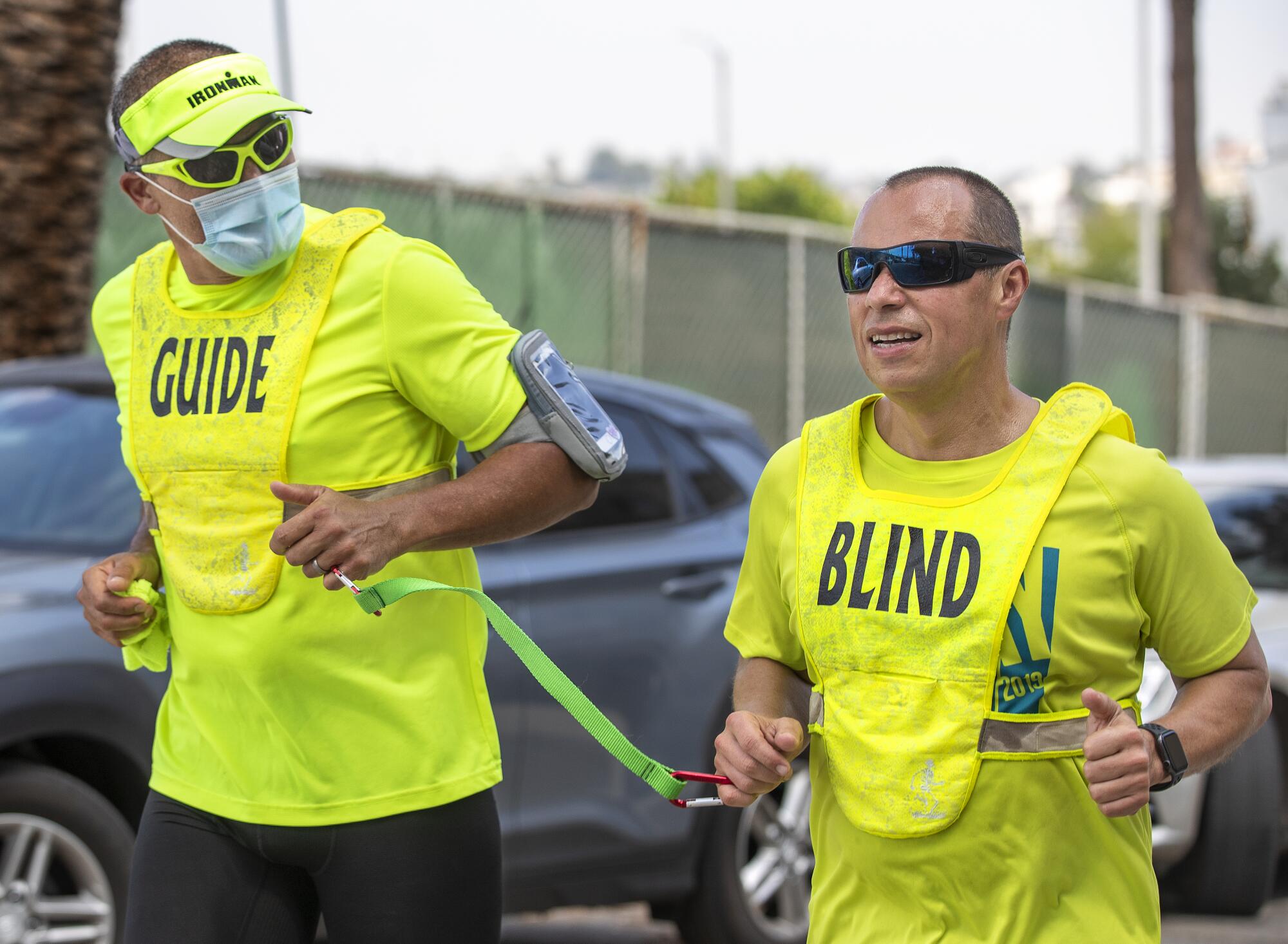
Indeed it was. Two weeks later, Alcanter and Duenas arranged for a trial run around a park in Silver Lake. As they embarked on the four-mile route, a light drizzle began to fall. A chilled breeze whipped against Duenas’ face. He could feel the earth flying by beneath his feet. Tears suddenly welled up in his eyes.
“I’ll never forget it,” Duenas said. “I’m running and I’m crying because I’m thinking, ‘Wow, I’m running in the rain.’ Even when I had sight, I never thought that I would be running. Really running.”
::
There are thousands of people around the country who feel the same way, a whole community of visually impaired runners and endurance athletes who have turned to the sport to retake control of their lives.
“You’re pretty much able to do and replicate the same feeling that other runners or endurance athletes would be able to experience,” said Chaz Davis, a blind U.S. Paralympic runner who works for the Massachusetts Assn. for the Blind and Visually Impaired. “[You’re] able to go out there and compete like everyone else, really feeling like you’re on the same playing field.”
A former Division I cross-country and track athlete at the University of Hartford who lost his vision when he developed a rare condition called Leber’s hereditary optic neuropathy at 19, Davis now manages MABVI’s Team With A Vision, which hosts the dozens of visually impaired runners who participate in the prestigious Boston Marathon every year.
“Being a part of that community is just really amazing. It becomes more than just, ‘I want to go out and get a workout.’ It’s much bigger than that.”
— United in Stride co-founder Richard Hunter
Davis also coordinates a service provided by MABVI called United in Stride, an online networking tool that connects visually impaired runners with sighted guides. He said its national database includes more than 2,500 blind athletes and roughly 1,000 guides.
“Being a part of that community is just really amazing,” said United in Stride co-founder Richard Hunter, a blind runner in Sacramento who has become a leading activist for visually impaired endurance athletes ever since he lost his sight in his 20s because of a condition called retinitis pigmentosa.
“It becomes more than just, ‘I want to go out and get a workout.’ It’s much bigger than that.”
Echoed Davis: “It’s a very strong and close-knit community.”
The COVID-19 pandemic, however, has started to pick at the seams.
Duenas’ routines have completely changed since the first serious wave of cases in March. Before, he would arrive at a nearby YMCA (“my second home,” he called it) by 5:30 almost every morning to run on the treadmill, swim laps in the pool or take a spinning class before dawn.
On the weekends, he would run, swim or ride a tandem bike with one of the more than 10 guides he regularly trained with, a network of aides built over the years through Facebook connections, the United in Stride service and other in-person encounters at races and events.
The guides did more than help Duenas train. They became the center of his social circle, close friends who treated him as more than someone simply with a disability. They pushed him to lower his marathon times (Duenas has qualified for the Boston Marathon three times) and gifted him wet suits and goggles once he began to swim.
A look at some of the best sports journalism produced by the Los Angeles Times in 2020.
One guide, Luis Montiel, raised almost $2,000 on GoFundMe to buy Duenas a tandem bike for his first triathlon. Another, Blake Cadwell, gave up the chance to complete his first Ironman race to guide Duenas instead. (Sighted guides in most races aren’t officially recognized as participants.)
“Having guides is the ticket to our freedom,” Duenas said. “To be able to do marathons, half-marathons, everything. They’re gold.”
But they can’t safely guide Duenas while maintaining six feet of social distance. As a result, he has only trained with a couple of his guides since March, cautiously spacing out his once weekly meet-ups several weeks apart.
Duenas’ YMCA has also been closed because of local health and safety guidelines. And his planned schedule of races — including the California International Marathon in Sacramento and another Ironman race in November — were canceled or postponed as well.
He once worked with others every day — those little moments that filled his life with meaning — but now he largely stays sheltered in his apartment, all alone.
“It has been terrible,” he said.
::
If being blind has taught Duenas anything, it’s the power of perspective.
In the same way he once took basic luxuries such as driving and reading for granted, he keeps the bigger picture in mind while discussing the loss of his workout routines. He knows there are greater hardships to bear.
Even in isolation, he has been able to stay in shape. He has a special stand that allows him to pedal his bike in place in his living room and had a pull-up bar installed in a hallway near his kitchen. He bought a set of weighted jump ropes and goes on long walks, sometimes even short runs, with his guide dog, Diana, a 7-year-old black Lab that has become another unexpected blessing of a life without sight.

“I never imagined I would love something alive as much as I love her,” Duenas said.
But nothing will completely fill the void last year brought. Duenas knows he won’t be able to run forever. These last 10 months have been precious lost time.
“I think about life, especially the future,” he said. “What does the future hold? What is my place in it? What am I going to do? Will I be able to survive in a few years? It’s really scary.”
Those fears recede, however, whenever Duenas is back running beside one of his guides. Even a recent one-mile trek with Alcanter, their neon vests strapped on for a there-and-back route along Council Street, was a welcome reprieve.
With the tether clasped in each others’ fingers, Alcanter warned Duenas of oncoming impediments every few steps.
“Bumps here,” he said as they crossed over a protruding sidewalk crack.
“And here,” as they strode past a pothole.
“It’s pretty clear now,” he told Duenas as they rounded the final corner before returning to his apartment.
The wind was whipping in Duenas’ face again, the ground once more flying by beneath his feet. He doesn’t cry anymore when he runs, his sightless eyes shaded by sunglasses. Instead, his mouth almost seems frozen in a perpetual grin. He just can’t help but smile.
More to Read
Get our high school sports newsletter
Prep Rally is devoted to the SoCal high school sports experience, bringing you scores, stories and a behind-the-scenes look at what makes prep sports so popular.
You may occasionally receive promotional content from the Los Angeles Times.


